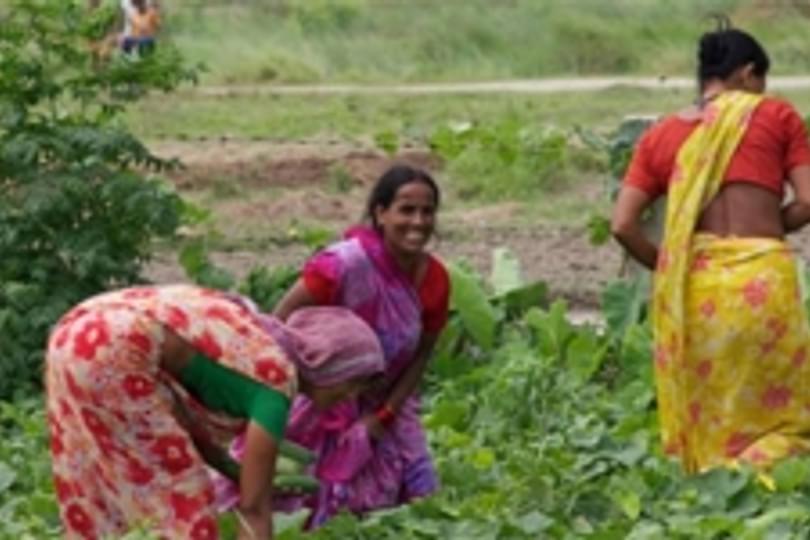
Jessica Thorn reports from Nepal on her work with the Systemic Integrated Adaptation programme of CCAFS (Climate Change Agriculture and Food Security), and reveals what adapting to climate change to ensure food security means at the local level.
Across Nepal’s breadbasket, smallholders have in the last 20 years observed a shift of the monsoon season by one month, increased intensity of rainfall, and shortened growing seasons. Farmers regularly are exposed to floods, and hotter months - resulting in crops losses from sedimentation or from surpassed temperature thresholds. Such changes mean farmers have to diversify to new cultivars such as peppermint and sunflower, new methods of cultivation through precision irrigation techniques, and managing new pest and disease vectors using integrated pest management.
In June 2013, I returned to Makrahar Village Development Committee (VDC), Rupandehi Nepal to conduct a community-based impact evaluation of a climate change adaptation planning pilot programme called Farms of the Future (FOTF), completed in summer of 2012. The pilot looked at how farmer exchanges could be used as a basis for an exploratory scenarios exercise, embedded in a programme to develop capacity for planning and decision-making under uncertainty and change.
This involved a four-month period where farmers were taken to three diverse climate alternatives based on the Climate Analogues Tool. Farmers visited villages to the West – Dang, and to the East - Chitwan, to explore other responses to the environmental and social changes that are predicted for their own village for 2030 – a period conceivable within their lifespan to plan for. They were then involved in a series of community-wide training and planning processes, and received some seed funding to start to put what they had learnt into action.
Through exploring the perspectives of farmers and partner organizations involved in this project, I uncovered some of the perceived benefits and limitations of the program, which can inform efforts to support planning and decision-making of farmers dealing with impacts of climate change. These benefits highlight how smallholder farmers, through collaboration, reflection, and shared learning can work towards reducing poverty, and enhancing food security in the face of rapid environmental change.
Diversification of crops grown and the role of community farming through the Garima Farmers Cooperative came across as particularly beneficial. In addition to the cooperative’s plans to expand to varieties of vegetables that grow well in shortened growing seasons, a group savings scheme will enable reinvestment in community projects, like aquaculture and poultry farming. Coupled with the project’s soil conservation training on intercropping methods, beneficial and harmful pests, and the preparation of non-chemically based pesticides or fertilizers from a local organisation, collaboration with the Forestry Office has meant farmers have started to consider areas beyond their farms, recognizing benefits of carbon sequestration, shade, aesthetic value, and enhanced soil fertility, and planting 500 leguminous trees and shrubs.
But besides these very tangible changes in management, benefits reached beyond community limits. Community-to-community knowledge exchanges helped to share best practices, particularly for those who did not partake in the initial pilot. During the evaluation, some people also mentioned how participation in the programme emphasized the value of education, and the opportunities such an education can bring.
Partnerships are key, and making those connections with well-established formal institutions - embedded in national government and bridging organisations - from the beginning can enhance local agencies’ understanding of real drivers of change, challenges, priorities, and innovations. Such partnerships can allow farmers access to a larger set of training programmes and grants, and mean that local staff are trained in participatory rapid appraisal methods. Training on a wider set of skills, such as financial management, conflict mediation, basic literacy and numeracy, and organizational management, can improve the likelihood of updating to new technologies.
I had come to Nepal to ask the question of what is the potential for climate models to inform planning and decision-making, from the perspectives of farmers and those working with them. Working with a people with a great taste for food, celebration, and spirit of generosity and kindness, I uncovered lessons that may also help them find different ways of responding to unprecedented environmental change. As the farmers of the Terai have found value in exploring potential climate scenarios, the lessons from this experience can also help inform those working with small-holders in other contexts. A few committed individuals can make a difference, through brief exposure to options available to them.
Jessica Thorn is a DPhil student at the Biodiversity Institute, University of Oxford
A longer version of this blog was orignially published on the Oxford Martin Programme on the Future of Food website
This opinion piece reflects the views of the author, and does not necessarily reflect the position of the Oxford Martin School or the University of Oxford. Any errors or omissions are those of the author.